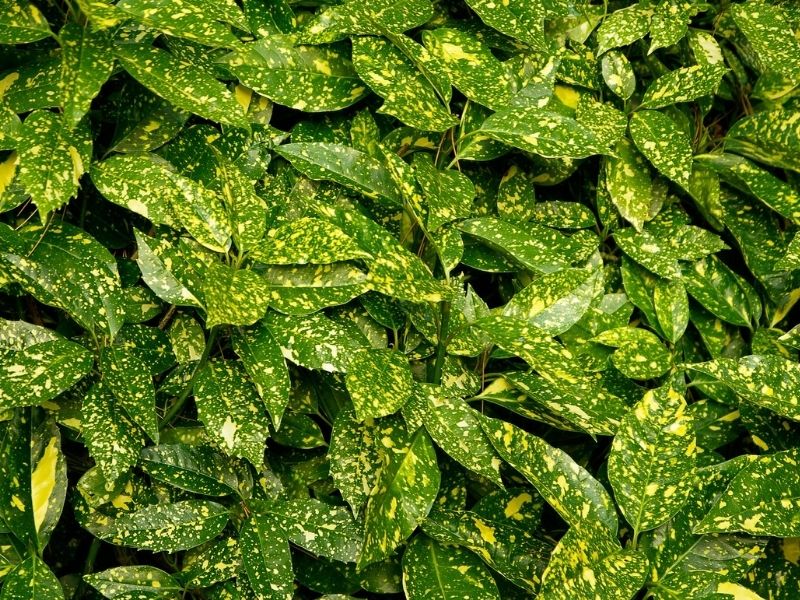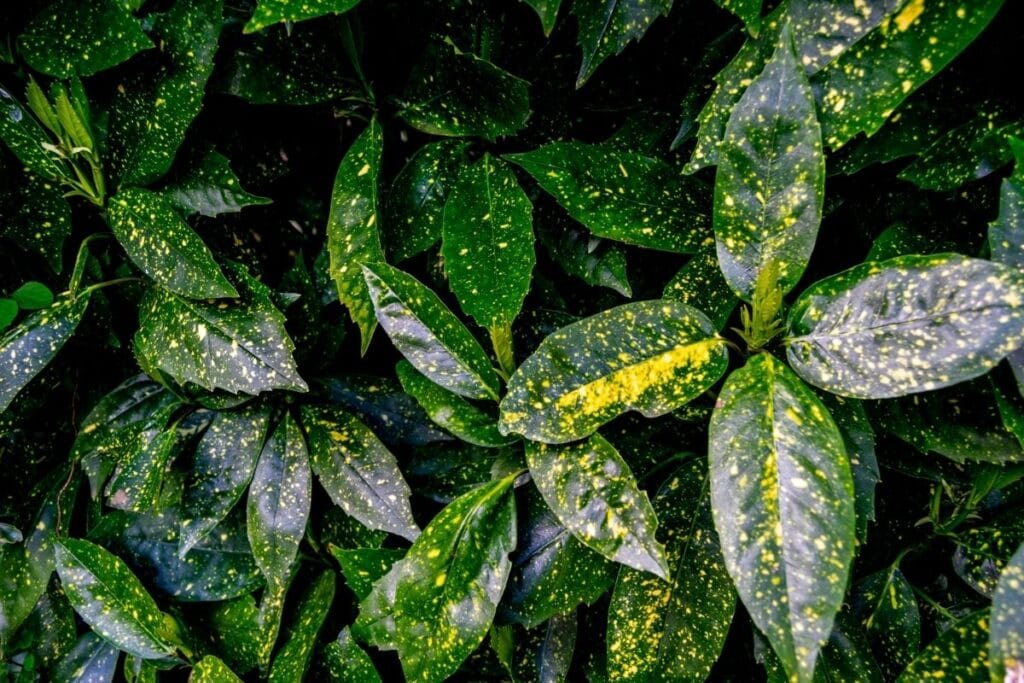Japanese laurel is a neat and useful evergreen shrub for zones 7 to 9. These plants are most popular for their incredible glossy foliage, and if you like the ‘variegated’ look, then this is one plant you should definitely take a closer look at.
Read on to learn more about how to grow and care for this shade-loving evergreen plant.
What Is A Japanese Laurel?
The Japanese laurel (Aucuba japonica) is a broadleaf evergreen shrub of the Garryaceae family. These plants are often known simply as aucuba, although they are also known as Japanese aucuba, spotted laurel, and gold dust plants.
Aucuba has a naturally dense and rounded growth form and can exceptionally reach heights of around 15 feet (4.6 m), although 6 to 7 feet (1.8 to 2.1 m) is more usual.
These plants are usually about as wide as they are tall. In the wild, Japanese laurel grows in thickets and moist woodland areas in Japan and other east Asian countries.
These plants have glossy, waxy leaves that are oppositely arranged. These leaves have smooth or toothed margins and can be up to about 7 inches (17.5 cm) long. The most popular forms in horticulture are the variegated leaf varieties, which are fantastically speckled in yellow and green.

Varieties/Cultivars
‘Variegata’ is the classic and popular variegated form of Japanese laurel. These plants are commonly known as gold dust. This is a female cultivar that tends to show the best leaf color in partial shade.
‘Picturata’ is a variegated form with predominantly yellow foliage with green margins.
‘Nana’ is a rounded dwarf form that has dark green leaves and will produce fruit if grown in proximity to and fertilized by a male plant. Variegated varieties of this dwarf form are also available.
‘Pacman’ is a low-growing dwarf variety with twisted and glossy, all-green leaves with toothed margins.
Japanese Laurel Flowers
Although attractive, these Aucuba plants are not well known for their rather small brown to purple and white flowers. These flowers have 4 petals and are produced in early spring.
While the flowers may not be showy, the bright red berries produced by female plants can be quite a colorful and attractive feature.
Aucubas are dioecious plants, which means a female must be fertilized by a male plant in order to produce fruits and set seeds. If you do have a male and female plant in close proximity, you may be fortunate enough to have your female plant produce attractive, bright red fruits of about ½ inch (13 mm) in length.
How To Grow A Japanese Laurel
Aucubas can be grown from both seed and cuttings. Growing these plants from seed is not difficult, although it is a slow process. The flesh of ripe fruits should be removed from the seeds and planted fresh. The seeds may take as long as 18 months to germinate. (1)
A much faster method of propagating new Japanese laurel plants is by cuttings. Semi-ripe cuttings taken in the late summer months root easily within 6 to 8 weeks and can be planted out the following spring. These plants begin to mature after about 3 to 4 years. (1)
These plants should be grown in full shade to partial shade and protected from strong cold winds.
Aucubas grow best in fairly rich, well drained soils. Although mature plants are somewhat drought resistant, young and newly planted specimens should be watered regularly and kept moist until established. Mixing in some topsoil, peat moss, and/or compost before planting in particularly sandy or quick-draining soil will assist in keeping moisture in the potting soil.
Aucuba japonica is a moderately cold-hardy plant that grows best in USDA hardiness zones 7 to 9, although plants in zone 6 can survive if grown in a protected area.
Applying a thick layer of mulch around the roots of plants grown in colder areas will help to prevent root damage from frozen soil. As a general rule, mulch should never be applied up to the base of a plant as this may encourage rot.

Aucuba Japonica Plant Care Guide
Slow-growing evergreen shrubs have pros and cons. On the bright side, these plants require very little maintenance and can be left to grow naturally into their tidy rounded form. These plants have a growing season that lasts from spring to fall.
These plants will benefit from the occasional pruning, and you can quite effectively encourage a denser growth form by pruning the previous year’s growth back by about a third.
Although these plants may reach heights of over 10 feet (3 m), they are easily kept to 3 or 4 feet (0.9 to 1.2 m) with occasional pruning. These plants should be pruned in the winter unless you are expecting a female plant to produce fruits, in which case it is better to wait until mid-spring and fruiting is over. Pruning is best done carefully with your pruners to avoid cutting the large attractive leaves. (2)
In soils that are not naturally rich, applying garden compost in the spring will improve plant growth and vigor. Avoid fertilizing late into the summer months, especially in colder areas, to avoid encouraging late new growth that may be damaged in the first frosts.
Japanese laurel is generally pests resistant but can be somewhat susceptible to scale. The most common problems these plants face are root rot from being grown in saturated soil and sunburn from receiving too much direct sunlight. Exposure to strong, cold winds can also damage the foliage of these beautiful evergreens.
Uses
Horticultural Uses
The spotted laurel has a great variety of uses in the landscape. These plants are often grown along shady borders or left to naturalize under trees where they provide rare color to a naturally dark area.
In the warmer zones, these plants do well in containers, although they can do equally well if grown as indoor plants in cool environments. These plants are even attractive enough to be grown as a specimen or accent plant.
Human Uses
The colorful fruits of this plant are not considered edible.
Wildlife Uses
Although the fruits of these plants are not eaten by birds, deer will eat the foliage.
FAQs
What causes Aucuba to turn black?
Aucuba leaves may turn black due to environmental stress, such as exposure to extreme temperatures, insufficient water, or fungal issues.
Does Aucuba like sun or shade?
Aucuba prefers partial to full shade and should be protected from direct sunlight, especially in hot climates.
How often do you water Aucuba?
Watering frequency for Aucuba depends on factors like the climate, soil moisture, and the plant’s specific needs. Still, it typically benefits from regular watering to keep the soil consistently moist, especially during dry periods.
Conclusion
A bright and beautiful evergreen plant that can be left to naturalize in shady areas could be a great asset to just about any garden in zones 7 to 9. Provided you aren’t in too hurry to see it grow, the Japanese laurel is a plant worth considering for your next gardening project.
Check our blog to see more shrubs to grow.
References
Reference List:
(1) Toogood, A. Plant Propagation: The Fully Illustrated Plant-By-Plant Manual Of Practical Techniques.
(2) Brickel, C. & Joyce, D. Pruning & Training: What, When & How To Prune.
Close
*image by Wirestock/depositphotos






